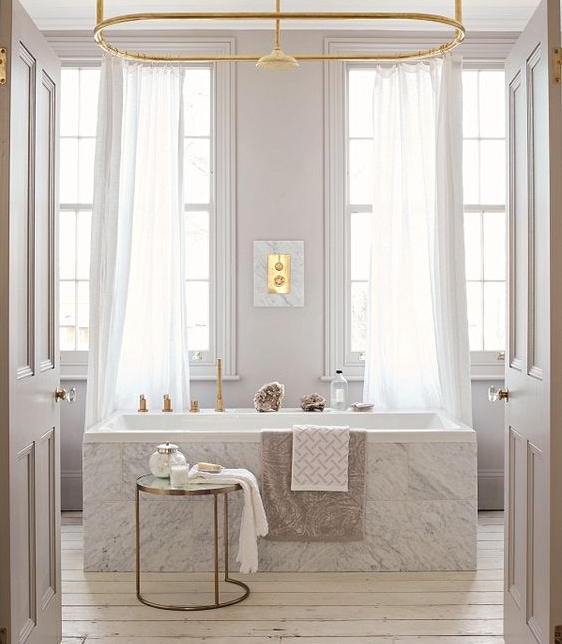
Imagine…
It’s morning, you get ready in your bathroom and you fill up with energy to live a positive and successful day.
In the evening, you take the time to relax and prepare yourself for a restful sleep.
In western feng shui, the bathroom is a vital center, just like the kitchen and the bedroom, because it is where we draw the energy we need for our daily lives. It is the essential room where we take care of ourselves, physically, psychically and emotionally. But, poorly arranged, it will have a negative impact on the whole house and your energy level.
Your interior designer is the right person to create the bathroom of your dreams, and if you want to design it in harmony with the philosophy of feng shui, incorporate these basic principles:
Principle n°1 to integrate in your bathroom design: CHOOSE THE RIGHT PLACE
When creating a new building or renovating your home, it is important to place the bathroom away from the center of the house.
See with your interior designer what can be done. Indeed, feng shui aims to harmonize the energies of the house and to promote the well-being of its inhabitants. The flow of water that characterizes this piece symbolizes the loss of vital energy and could cause health problems. Placed in the center of the house, it would negatively impact all the rooms (zones) of the house. To be verified on the plans.

Principle n°2 to be integrated in the design of your bathroom: DESIGN WITH RESPECT TO ENERGY FLOW
The energy that circulates in the rooms has an impact on your well-being, too dynamic, it can be a source of tension and fatigue, too low, it will generate a certain boredom, a lack of drive.
In the bathroom, the energy flowing between the door and the window is very dynamic. If your bath is in the energy flow, you may not stay there long and the expected relaxation may not be complete. There are remedies for this: put a curtain over the window to calm the energy, and/or place a green plant near the bath.
Principle n°3 to be integrated in your bathroom design: PROMOTE A POSITION OF CONTROL
In western feng shui, the mastery position is the fact of having a view on the door when you are lying in your bath, it brings a sense of security. If this is not possible, place a large mirror so that you can see the entrance when you are in the bath.
The same goes for the location of the sinks, you should also be able to see the entrance from where you are.
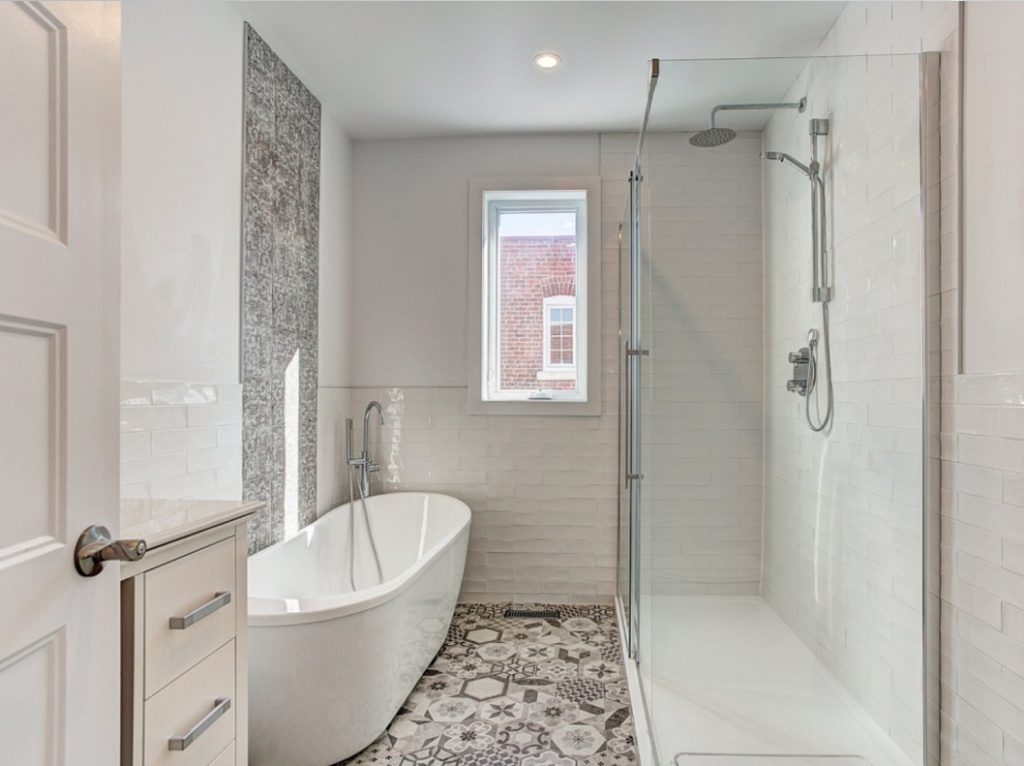
Principle n°4 to integrate in the design of your bathroom: Hanging furniture
Hanging furniture will limit floor space and therefore optimize energy flow. The laundry basket will be hidden, your interior designer will take care when designing your bathroom to avoid as much as possible all areas of stagnation of energy.
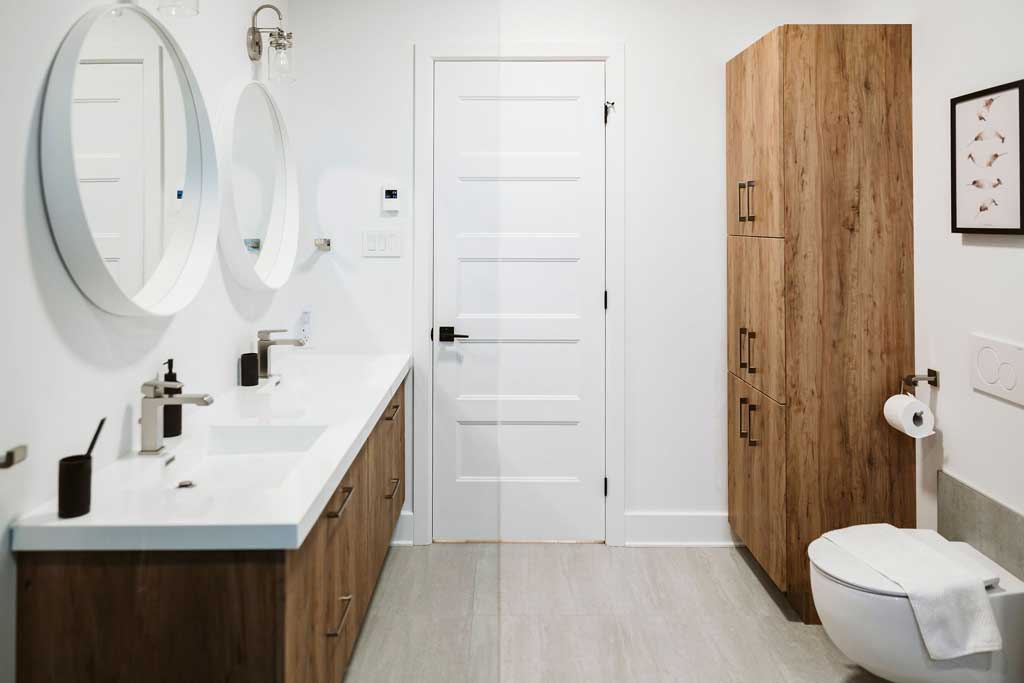
Principle #5 to incorporate into your bathroom design: PROMOTE SELF-IMAGE
It is in your bathroom that you will take care of your image and nourish a feeling of well-being. You will take time for yourself and fill up with energy that will flow through your body throughout the day.
Choose large mirrors. If the mirrors are too small, they symbolize a devalued self-image. Also with a feng shui bathroom in mind, eliminate mirrors with tiles or multiple parts, which reflect a fragmented image of yourself and therefore do not contribute to a good self-image.
Avoid placing mirrors in front of the toilet. In feng shui, the mirror multiplies the energies and thus the losses caused by the toilet.
Principle n°6 to integrate in the design of your bathroom: PROVIDE A SOFT AND WARM AMBIENCE
The bathroom is a space of well-being where we take care of our body and mind. It must therefore inspire relaxation and harmony. Observe how you feel when you are in your bathroom. If you don’t feel like spending time in your bathroom and you don’t find serenity in it, it’s probably because changes need to be made in the layout and design of your bathroom.
In western feng shui, white is appropriate in the decoration of the bathroom, because, it symbolizes purity, cleanliness and hygiene, but it might be too cold and not invite relaxation. A few ceramic tiles in warm colors will warm up the atmosphere. The accessories will be chosen in the same spirit. The decorative niches planned by your interior designer will be able to receive a wooden shelf. Wood is used in feng shui to temper energy loss.
A good balance of shapes and materials will contribute to the harmony. A very angular arrangement will bring too much dynamism, roundness in the forms will bring softness. Choose smooth materials for easy maintenance.
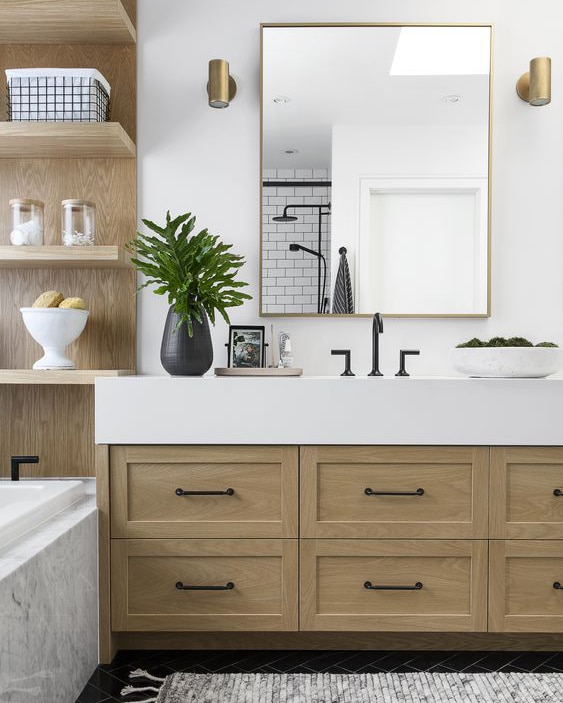
Source Pinterest
Principle #7 to integrate into your bathroom design: EFFICIENT VENTILATION
The bathroom being the most humid room in the house, it is essential that it be well ventilated in order to maintain a healthy atmosphere and to allow the energy to circulate well.
The door should however be closed, as well as the toilet seat, it is a feng shui principle in this place, which aims to curb energy losses.
Open the window regularly for optimal ventilation. If the bathroom is adjacent to the bedroom, these principles are even more essential, the atmosphere charged with humidity and therefore stagnant energy could negatively impact your sleep.
Principle #8 to integrate into your bathroom design: WELL-DOSED LIGHT
Light is vital energy. If the layout of your bathroom allows it, favor natural light as much as possible.
The lighting fixtures will be carefully chosen to provide a soft and warm light in strategic places, above the sink, near the mirror. It is a question of not abusing it, because water and electricity (fire element in feng shui) do not mix well.
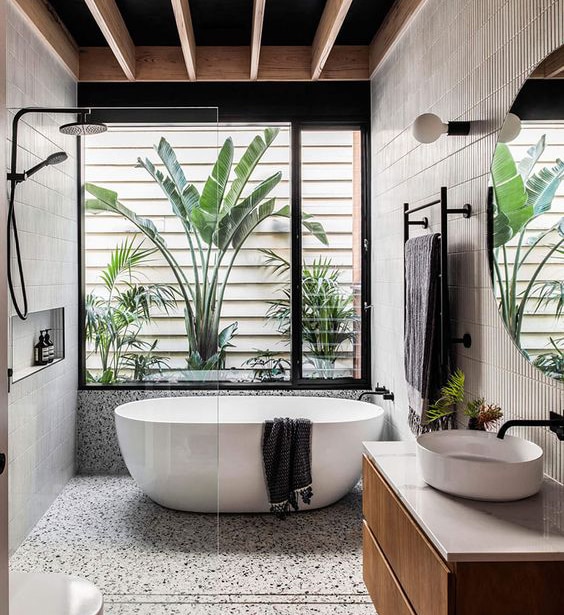
Source Pinterest
In conclusion
Feng shui’ is an ancestral art that originated in China. The West was inspired by this philosophy to create a feng shui more adapted to our environment and our mentalities. Western feng shui aims at harmonizing the energy flow in the house and in the rooms in order to positively impact its inhabitants on a daily basis. And as we have seen, rules in the design and decoration of the bathroom allow us to obtain a balance between the dynamic energies (yang) and the calmer energies (yin).
Author of the text:
Stéphanie Brimont Thirriard, interior designer
